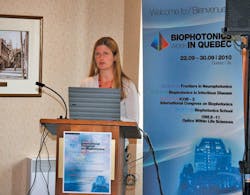BIOPHOTONICS TECHNOLOGY ROADMAPPING: Branding, front-line involvement, and funding were themes at bio-optics congress
Biophotonics Week in September brought together approximately 300 people for two conferences (Frontiers in Neurophotonics and Optics Within Life Sciences), a workshop (Biophotonics in Infectious Disease), and a graduate school (Biophotonics School)—in addition to the second International Congress on Biophotonics (ICOB-2), which was the pivotal meeting of the event series, organized by the Canadian Institute for Photonic Innovations (CIPI), with participation and sponsorship from multiple organizations around the world.
During ICOB-2, researchers from academia and industry, representatives from funding agencies, educators, end-users, and other stakeholders contributed ideas for a strategic roadmap on the future of biophotonics research, technology development and education. The goal of the roadmapping exercise is to identify markets and optimize technology opportunities in order to deliver on the promise of biophotonics as a top enabling technology.
This year's congress followed in the footsteps of ICOB-1, held in 2008 in Sacramento, CA (see Bio-optics lollapalooza in Quebec: Five events in one, May/June 2010), with three application themes: Neurosciences, Infectious diseases, and Drug discovery & development. Participation was by invitation only, and included thought leaders in their fields, representing universities, companies, government agencies, and foundations from five continents. Presenters were asked to share "big picture" examples of substantive challenges in clinical medicine and biosciences, and new approaches to addressing these challenges using existing and emerging biophotonics-based technologies. Panelists were asked to contribute their insights from their experience at the intersection of light and life sciences, as clinicians, researchers, company scientists or executives, investors, government funding and policy makers, and educators. A college of writers distilled and prioritized the information gathered throughout each of the three days, to set the base for the final roadmap. All participants were urged to think outside the box, to ask probing questions, to be controversial and let their imagination run free. Today's crazy ideas may well turn out to be tomorrow's cures, the organizers reasoned.
Elizabeth Hillman, professor of biomedical engineering at Columbia University, speaks at the International Congress on Biophotonics on the drug discovery and development application theme.
The three themes
Aside from specific needs and recommendations for each application theme, a few overarching messages emerged. One is the need for more sustained branding of biophotonics as an extremely promising field, which also constitutes an ideal example of interdisciplinary science used to attract more students to study science, technology, engineering and mathematics (STEM), and prepare for STEM careers. Another message was the recommendation to involve clinicians and bioscientists as early as possible in the process of biophotonics technology development, in order to validate the need from the end-user perspective, and to increase acceptance and adoption of new technologies that make it to the market. Lastly, the challenge of gap funding for technology maturation, also identified at ICOB-1, seems to have only gotten worse, due in part to the general economic malaise.
Roadmaps for each of the three application themes of ICOB-2 will be finalized in the coming weeks and shared—via the Biophotonics World website (www.biophotonicsworld.org) and other channels—with the worldwide community of biophotonicists, government agencies and other funding bodies, and policy makers. ICOB-2 co-chairs Brian Wilson (professor of medical biophysics at the University of Toronto, and biomedical theme leader at the Canadian Institute for Photonic Innovations) and Dennis Matthews (professor and director of the National Science Foundation-funded Center for Biophotonics, Science & Technology [CBST] at the University of California–Davis), are leading this effort, based on extensive notes and materials gathered throughout the Congress.
"Sustained efforts will be necessary in order to address these needs and challenges," the organizers note, but "a collaborative biophotonics community, and strong leadership, can put its mark on the future of the field and greatly impact biosciences and medicine."
ICOB is part of—and is fueled by—a larger initiative, Biophotonics4Life Worldwide Consortium, whose mission is to harness global talent and resources and focus them on the most important end-user needs. To this end, the consortium connects nodes of biophotonics researchers, educators, organizations, companies, and others into a virtual community. The associated Biophotonics World website constitutes a knowledge bank for the field and a means for establishing networks and communication among members of the biophotonics community. —Gabriela Lee
GABRIELA LEE is director of partnerships and new program development at CBST, and program manager of Biophotonics4Life.
More BioOptics World Current Issue Articles
More BioOptics World Archives Issue Articles
